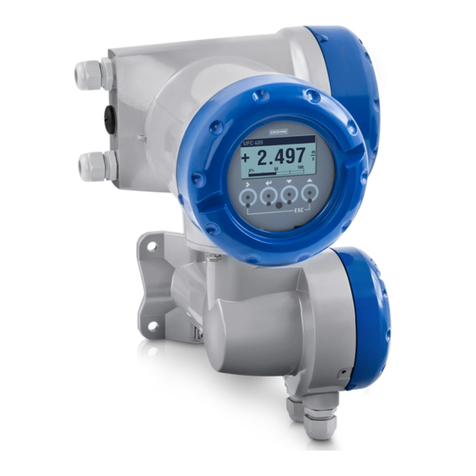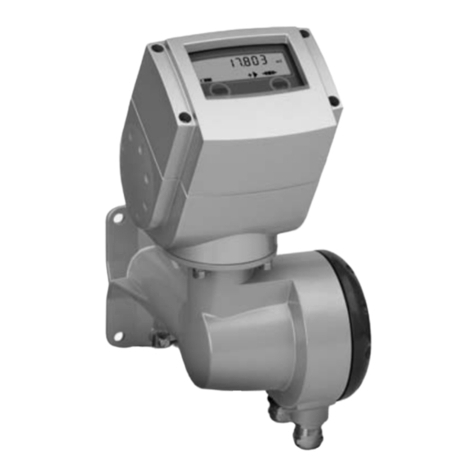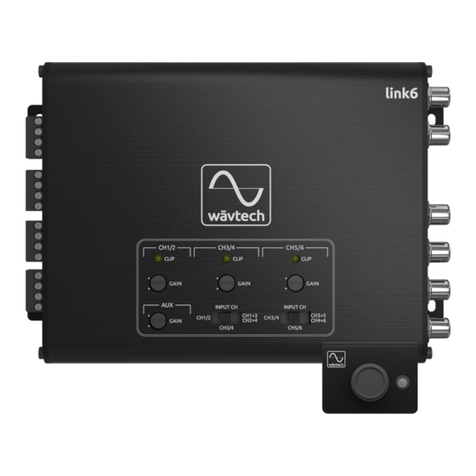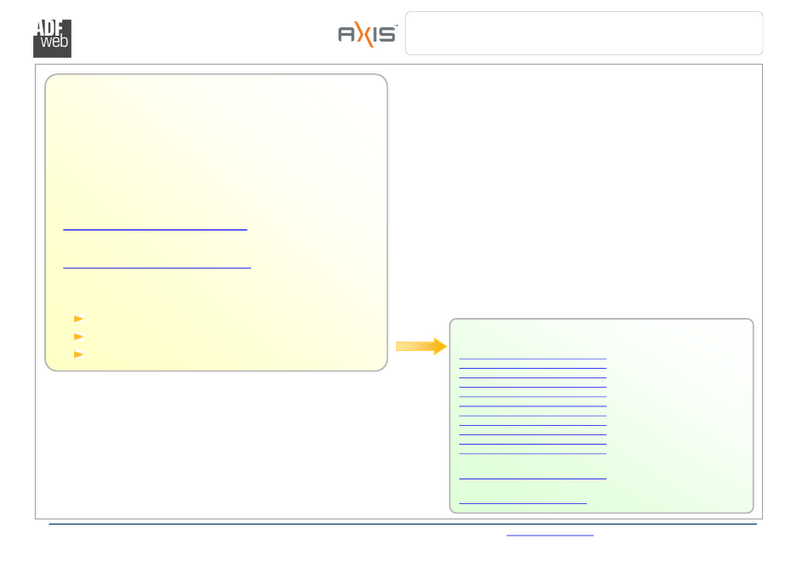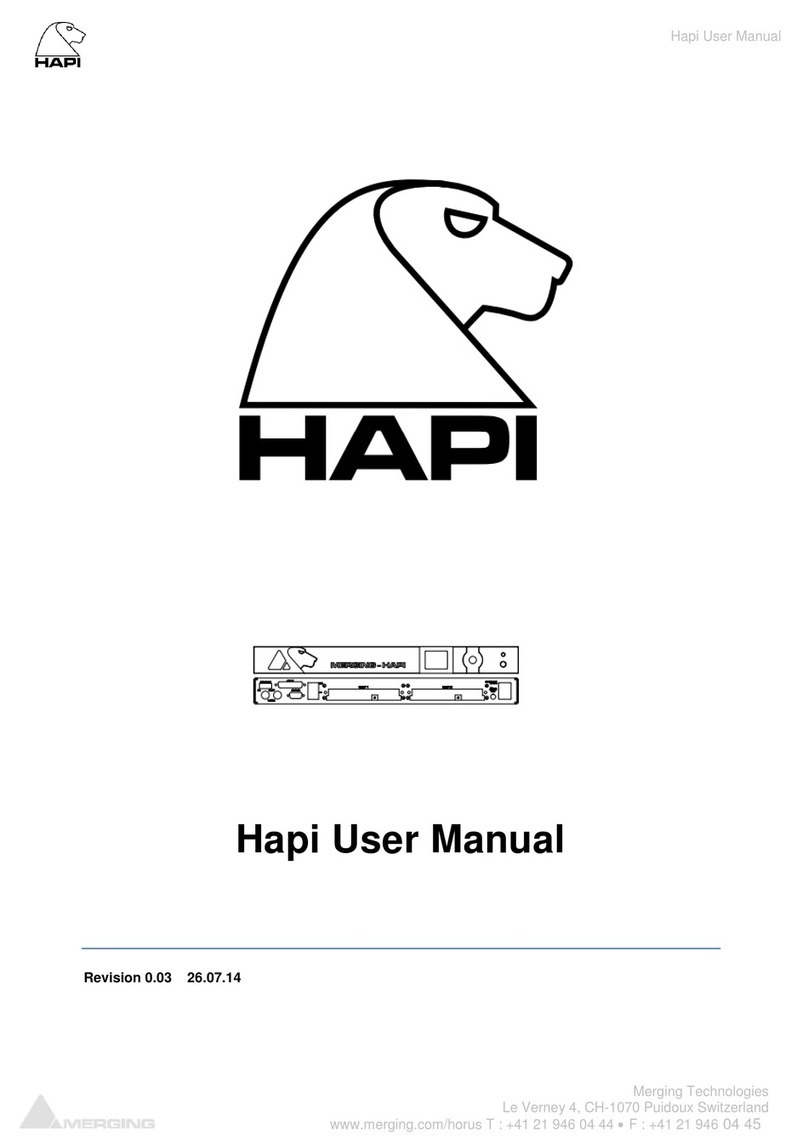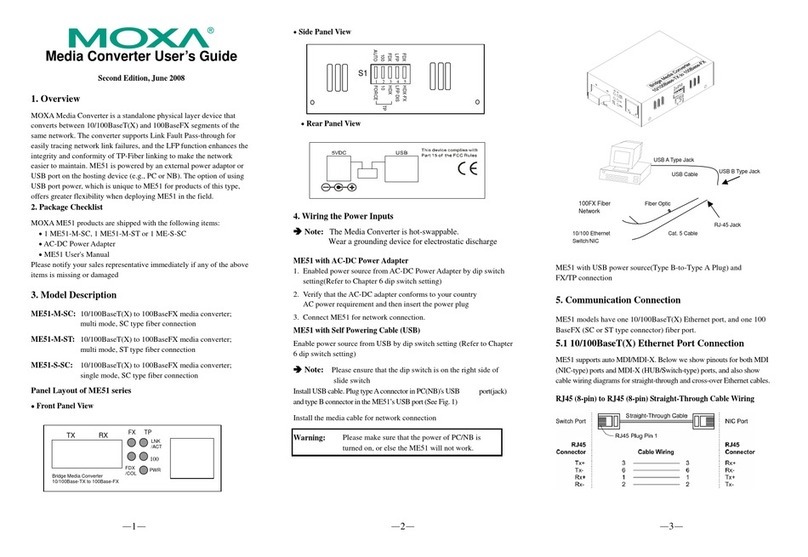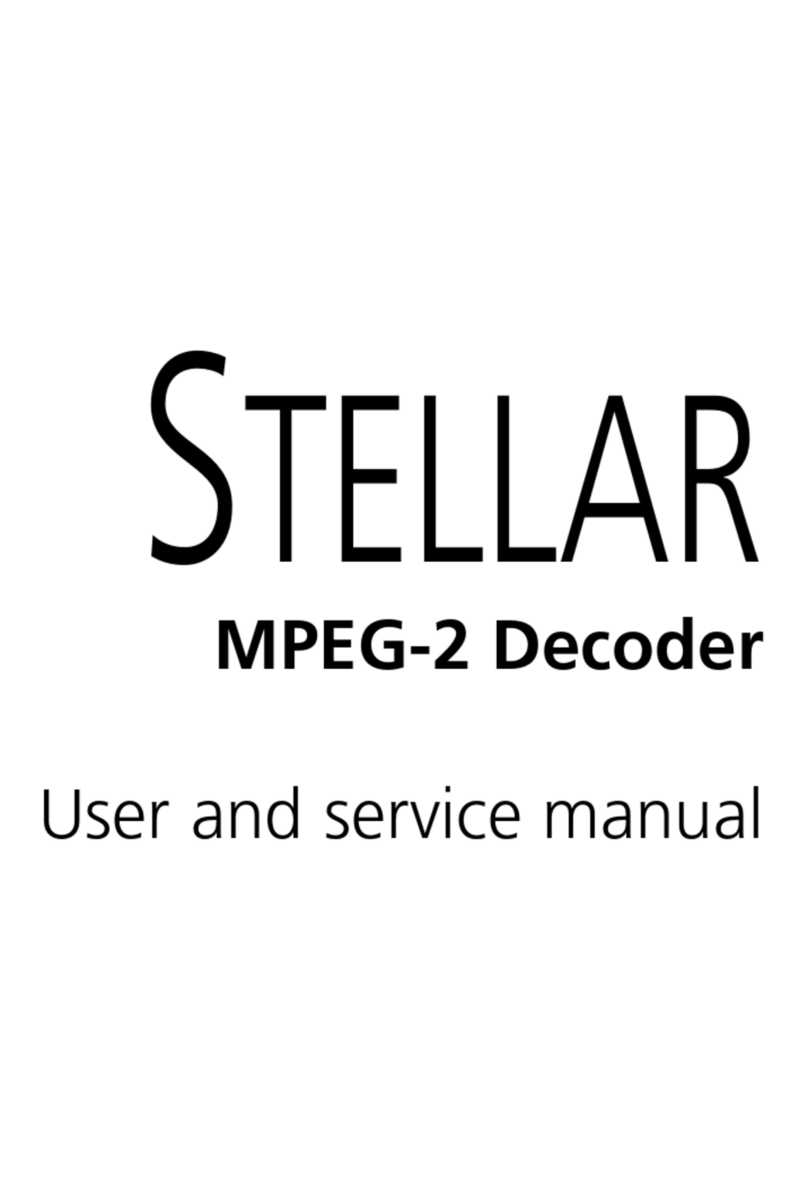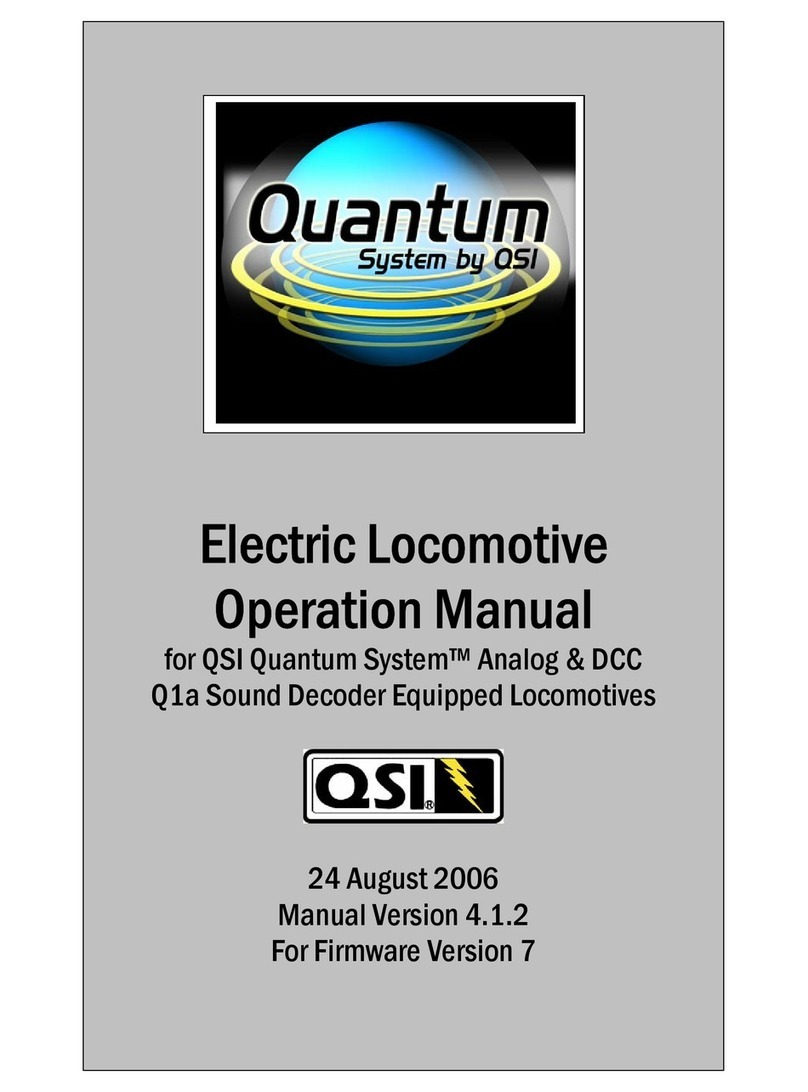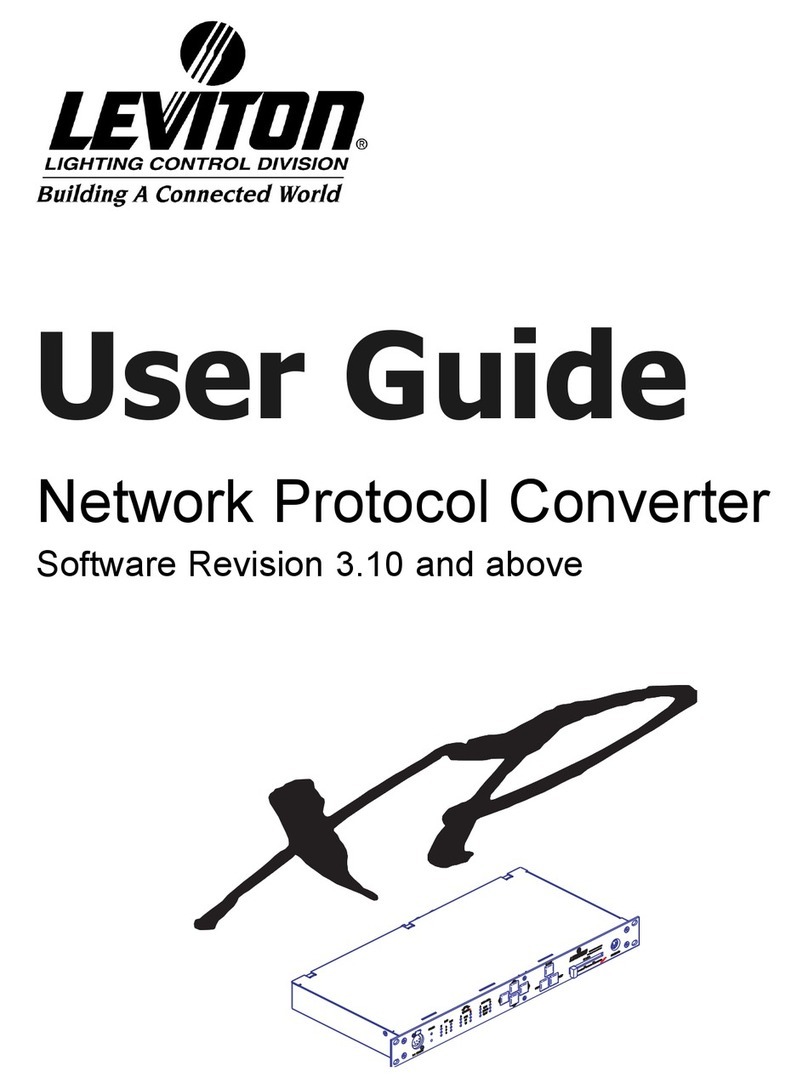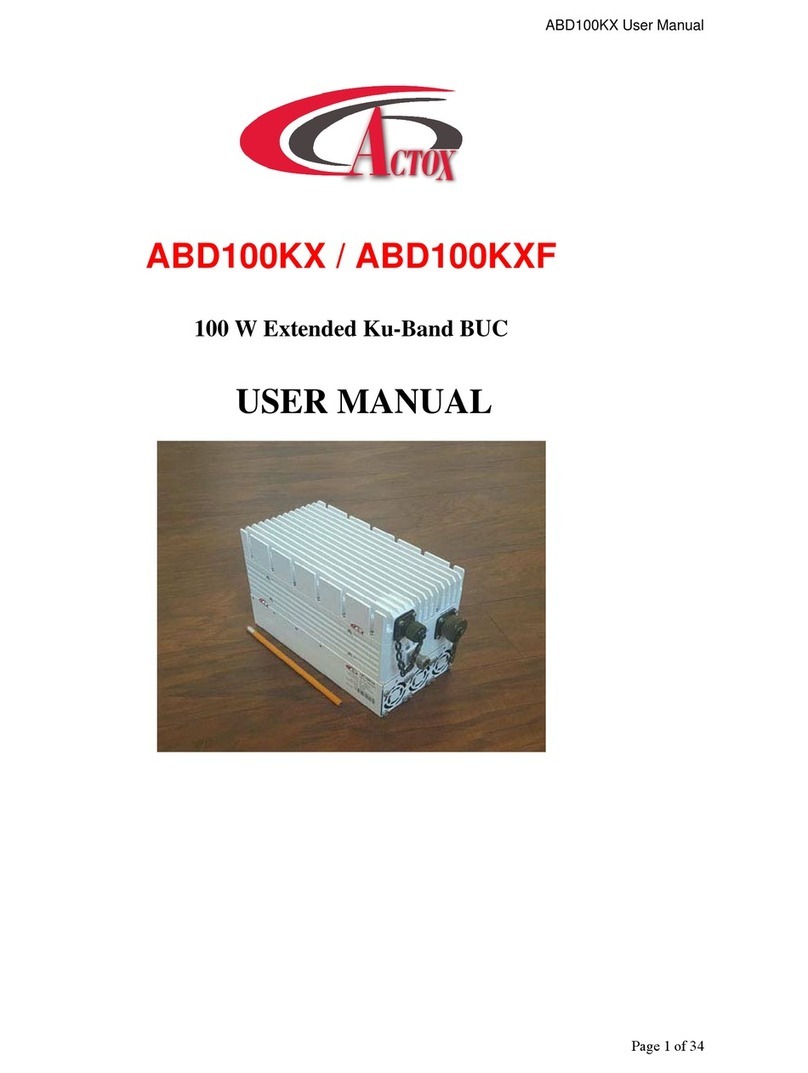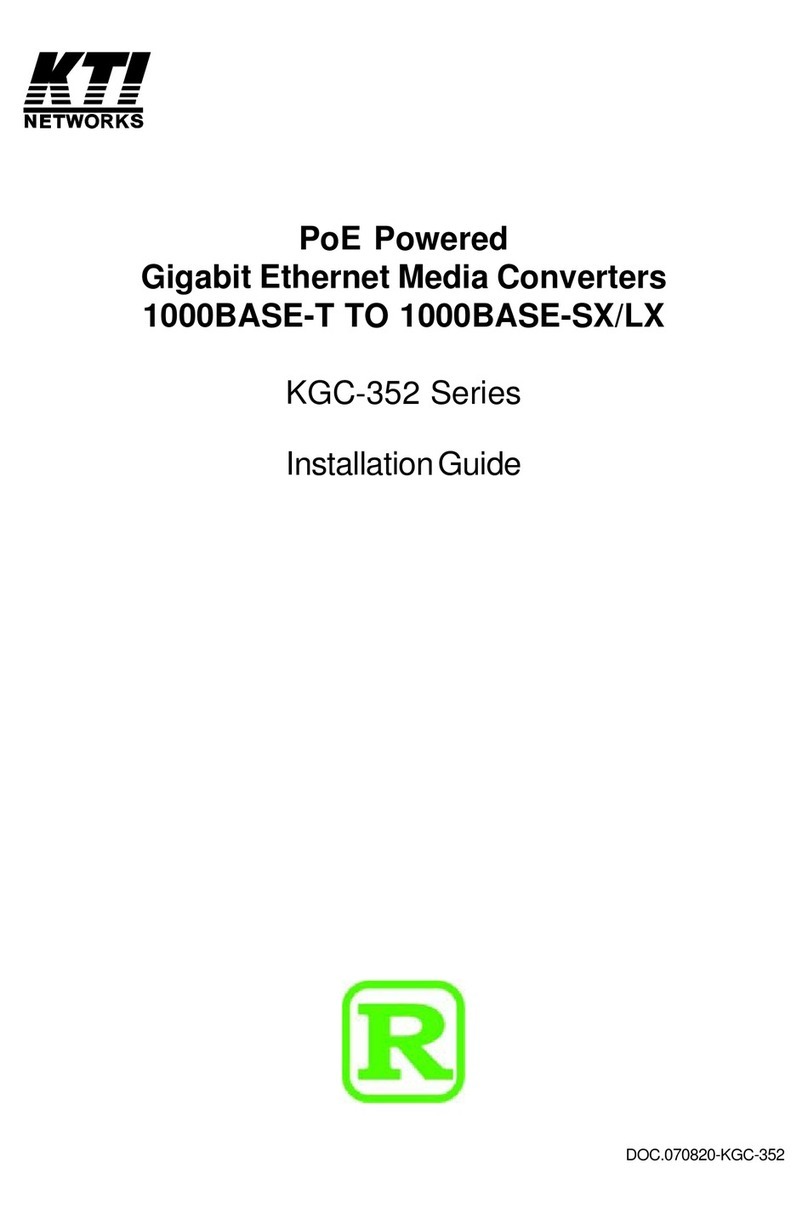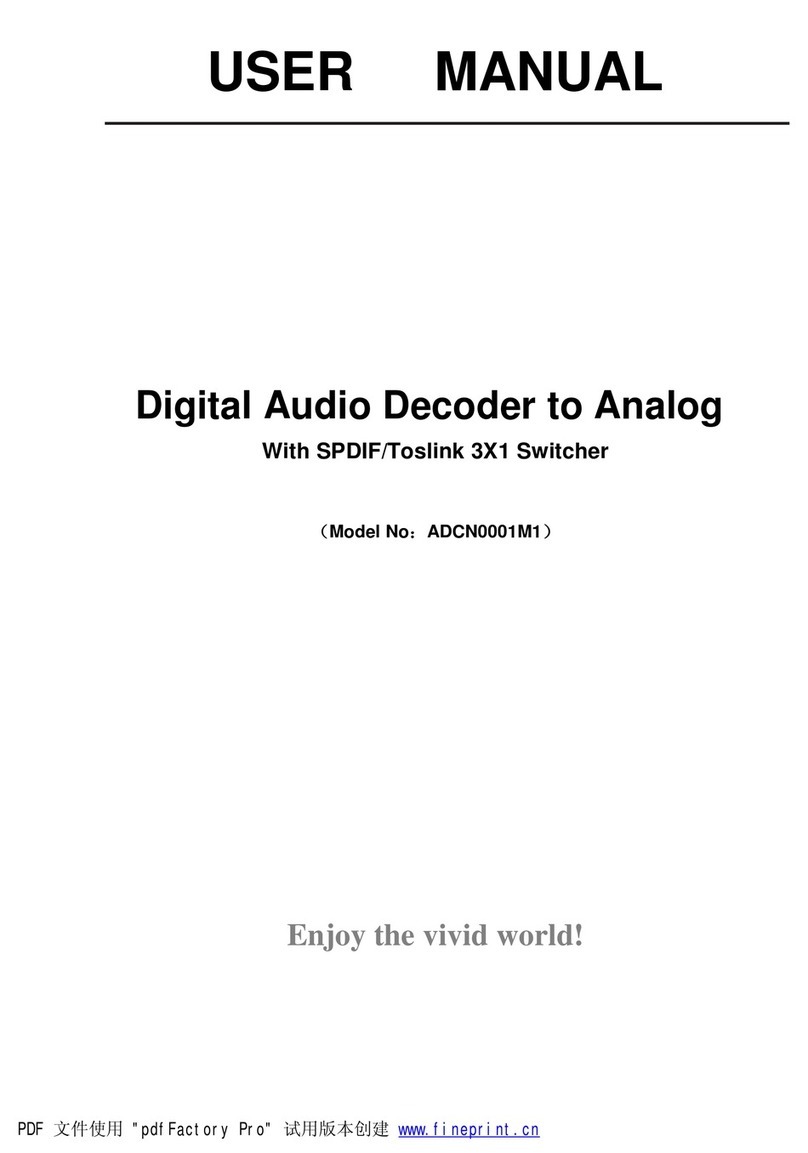KROHNE IFC 010 K User manual

Installation and
operating
intructions
Signal converters
for
electromagnetic flowmeters
04/98
How to use these Instructions
The flowmeters are supplied ready for operation.
The primary head must be installed in the pipeline as described in the installation
instructions inside the packing of the primary head.
- Installation location and connection to power (Section 1) Pages 1/1-1/6
- Electrical connection of outputs and inputs (Section 2) Pages 2/1-2/6
- Factory settings and start-up (Section 3) Pages 3/1-3/2
-Operator control of the signal converter is described in Sections 4 and 5.
Power the flowmeter. THAT’S ALL. The system is operative.
16-page pull-out condensed instructions
are located in the centrefold of these Installation and Operation Instructions.
Contents:
Installation (Sect. 1), electrical connection (Sect. 1 + 2),
start-up (Sect. 3) and operator control of the signal converter (Sect. 4)
3.1M61EA4 049821 Order No. 7.02140.34.00
US size: 7.02140.74.00
IFC 010 K
IFC 010 F
Applicable to
Software Versions
••IFC 010 _/ D
Display version
No. 806325.07
and
No. 317551.02
and higher
••IFC 010 _/ B
Basic version
operator-controllable
with HHT 010
No. 806323.06
and higher

0/1
Contents
Versions IFC 010 signal converter 0/3
Items included with supply 0/3
Software history 0/3
System description 0/4
Product liability and warranty 0/4
CE / EMC / Standards / Approvals 0/4
Part A System installation and start-up 1/1-3/2
1 Electrical connection: power supply 1/1-1/6
1.1 Important installation notes – PLEASE NOTE ! 1/1
1.1.1 Location 1/1
1.1.2 Only for separate systems/signal converters (F versions) 1/1
1.1.3 Cable entries 1/1
1.2 Connection to power 1/2
1.3 Electrical connection of separate primary head (F Version) 1/3-1/6
1.3.1 General information on signal cable A and field current cable C 1/3
1.3.2 Grounding of primary head 1/3
1.3.3 Stripping (preparation) of signal converter 1/4
1.3.4 Cable length (max. distance between signal converter and primary head) 1/5
1.3.5 Connection diagrams I and II (power supply, converter and primary head) 1/6
2 Electrical connection of outputs 2/1-2/2
2.1 Current output I 2/1
2.2 Pulse output P and status output S 2/1
2.3 Connection diagrams for outputs and inputs 2/2
3. Start-up 3/1-3/2
3.1 Power-on and measurement 3/1
3.2 Factory settings 3/2
Part B IFC 010 /D Signal converter 4/1-5/14
4 Operation of the signal converter 4/1-4/10
4.1 Krohne operator control concept 4/1
4.2 Operating and check elements 4/2
4.3 Function of keys 4/3-4/4
4.4 Table of settable functions 4/5-4/9
4.5 Error messages in measuring mode 4/9
4.6 Reset totalizer and cancel error messages, RESET/QUIT menu 4/10
4.7 Examples of setting the signal converter 4/10
5 Description of functions 5/1-5/12
5.1 Full-scale range Q100% 5/1
5.2 Time constant 5/1
5.3 Low-flow cutoff 5/2
5.4 Display 5/2-5/3
5.5 Internal electronic totalizer 5/3
5.6 Current output I 5/4
5.7 Pulse output P 5/5-5/6
5.8 Status output S 5/7
5.9 Language 5/8
5.10 Entry code 5/8
5.11 Primary head 5/9
5.12 User-defined unit 5/10
5.13 F/R mode, forward/reverse flow measurement 5/11
5.14 Characteristic of outputs 5/11
5.15 Applications 5/12
5.16 Setting data 5/12

0/2
Part C Special applications, functional checks, service, and order numbers 6/1-9/1
6 Special applications 6/1-6/2
6.1
HHT 010 hand held terminal and RS 232 adapter incl. CONFIG software (options)
6/1
6.2 Stable signal outputs when measuring tube empty 6/2
7 Functional checks 7/1-7/11
7.1 Zero check with IFC 010 /D, signal converter, Fct. 3.03 7/1
7.2 Test of measuring range Q, Fct. 2.01 7/1
7.3 Hardware information and error status, Fct. 2.02 7/2
7.4 Faults and symptoms during start-up and process flow measurement 7/3-7/6
7.5 Test of primary head 7/7
7.6 Test of signal converter 7/8
7.7 Test of signal converter using GS 8A simulator (option) 7/9-7/11
8 Service 8/1-8/6
8.1 Cleaning the signal converter housing 8/1
8.2 Replacement of power fuse(s) 8/1
8.3 Changeover of operating voltage on AC Versions 1, 2 and 3 (not DC Version) 8/2
8.4 Replacement of electronic unit of signal converter 8/2
8.5 Illustrations to Sect. 8.2 to 8.7 8/3
8.6 Turning the display PCB 8/4
8.7 Retrofitting the display unit 8/4
8.8 IFC 080 and SC 80 AS Replacement of electronic unit by IFC 010 8/4
8.9 Illustrations of the PCBs 8/6
9 Order numbers 9/1
Part D Technical data, measuring principle and block diagram 10/1-12/1
10 Technical data 10/1-10/5
10.1 Full-scale range Q100% 10/1
10.2 Error limits at reference conditions 10/2
10.3 IFC 010 Signal converter 10/3-10/4
10.4 IFC 010 F and ZD dimensions and weights 10/4
10.5 Instrument name plates 10/5
11 Measuring principle and function of the system 11/1
12 Block diagram - signal converter 12/1
Part E Index E1-E2
Printed form to accompany flowmeters returned to Krohne E3

0/3
Versions IFC 010 signal converter
IFC 010_ / B Basic version (standard)
without local display and control elements.
All operating data factory-set to your order specifications.
Optionally available for operator control:
- RS 232 adapter, incl. software for DOS-PC or
- HHT hand-held terminal
IFC 010_ / D Display version (option)
with local display and control elements.
All operating data factory-set to your order specifications.
IFC 010 K / _ Compact flowmeter
signal converter mounted direct on primary head.
IFC 010 F / _ Signal converter in field housing,
electrical connection to primary head
via field power and signal cables.
Items included with supply
• Signal converter in the version as ordered, see above.
• These installation and operating instructions for the signal converter,
including 16-page pull-out condensed instructions for installation, electrical connection,
start-up and operator control of the signal converter.
• 2 plug connectors for connection of power supply and outputs/inputs
• for separate system version only, F Version:
signal cable in the version and length as ordered (standard: signal cable A, length 10 m / 30 ft)
Software history
Display & control unit Hand-held HHT 010 CONFIG user software
IFC 010 _ / D IFC 010 _ / B** IMoCom RS 485
Software Status Software Status Software Software
806325.07*current 806328.06 current
replaces V 2.00 V 3.15
≥317551.02*806325.07 806328.06 current and higher and higher
813269.00*** current Czech user interface ***
813340.00*** current Swedish user interface ***
*At least the same setting ranges and functional scope as preceding versions.
Also, customer- and application-specific add-on equipment possible, which has to be
installed and activated by the factory. Documented by enclosures to these Installation
and Operating Instructions.
** Please note: Connect HHT 010 only to devices without display and operator
control software.
*** Does not contain the functional scope of the currently valid standard version;
this has been taken into account in the documentation of the respective national language.

0/4
CE / EMC / Standards / Approvals
System description
Electromagnetic flowmeters with the IFC 010 signal converter are precision instruments designed
for linear flow measurement of liquid products.
The process liquids must be electrically conductive: ≥5µS/cm
(for cold demineralized water ≥20 µS/cm).
The full-scale range Q100% can be set as a function of the meter size:
DN 2.5.- 1000 / 01/10” - 40” Q100% = 0.010- 34 000 m3/hr = 0.03 - 151 000 US Gal/min
This is equivalent to a flow velocity of 0.3 - 12 m/s or 1 - 40 ft/s.
Product liability and warranty
The electromagnetic flowmeters with the IFC 010 signal converter are designed solely for
measuring the volumetric flowrate of electrically conductive, liquid process products.
These flowmeters are not certified for use in hazardous areas. Other flowmeter series are
available for such applications.
Responsibility as to suitability and intended use of these electromagnetic flowmeters rests solely
with the operator.
Improper installation and operation of the flowmeters (systems) may lead to loss of warranty.
In addition, the “General conditions of sale” forming the basis of the purchase contract are
applicable.
If flowmeters need to be returned to Krohne, please note the information given on the last-but-one
page of these Instructions. Krohne regrets that it cannot repair or check your flowmeter(s) unless
accompanied by the completed form sheet.
• Electromagnetic flowmeters with the IFC 010 signal converter meet the protection requirements
of Directive 89/336/EEC in conjunction with EN 50081-1 (1992) and EN 50082-2 (1995),
as well as Directives 73/23/EEC and 93/68/EEC in conjunction with EN 61010-1, and bear the
CE marking.

1/1
Part A System installation and start-up
1.1.1 Location
• Electrical connection in accordance with VDE 0100 ”Regulations governing heavy-current
installations with line voltages up to 1000 V” or equivalent national regulations.
•Do not cross or loop cables inside the terminal compartment.
•Use separate cable entries (see below) for power supply, field current cables, signal lines,
outputs and inputs.
•Protect flowmeters or switchgear cabinets with built-in devices from direct sunlight.
Fit a sunshade if necessary.
•When installed in switchgear cabinets, signal converters must be adequately cooled,
e.g. use fans or heat exchangers.
•Do not expose signal converters to intense vibration.
1.1.2 Only for separate systems/signal converters (F versions)
•Keep distance between primary head and signal converter as short as possible.
Refer to Sect. 1.3.4 for maximum permissible length of signal and field current cables.
•Use the supplied Krohne signal cable A (Type DS), standard length 10 m (33 ft).
•Always calibrate primary head and signal converter together. Therefore, when installing,
ensure primary constant GKL is identical; refer to instrument nameplate for the primary
head. If the GKL is not identical, set the signal converter to the GKL of the primary head.
Refer also to Sections 4.
• Dimensions of signal converter; refer to Section 10.4.
1.1.3 Cable entries
Number of cable entries: 2 for the compact flowmeters
4for the IFC 010 F signal converter
NOTE: Ensure gaskets are fitted correctly and maintain
the following max. torques!
1Max. torques for PG 13.5,
1/2“ NPT or 1/2“ PF adapters: 4 Nm / 2.8 ft xlbf
2Max. torques for PG 13.5 only: 3 Nm / 2.1 ftxlbf
3Gasket
A) PG 13.5 cable entries
These cable entries may only be used for flexible electrical cables if the relevant electrical
regulations so allow, e.g. National Electric Code (NEC).
Do not fix rigid metal conduits (IMC) or flexible plastic conduits to the PG 13.5 cable entries, refer
to “Point B, C” below (1/2” NPT or PF adapters).
B) 1/2“ NPT adapters C) 1/2“ PF adapters
For most North American systems the regulations require that electrical conductors be laid in
conduits, particularly where power voltages > 100 V AC are concerned.
In such cases, use the 1/2” NPT or 1/2” PF adapters to which flexible plastic conduits can be
screwed. Do not use rigid metal conduits (IMC)!
Lay conduits such that no moisture can penetrate into the converter housing.
Should there be risk of any condensation water forming, fill the cross-section of the conduit
around the cables at these adapters with a suitable sealing compound.
3
1
2
1 Electrical connection: power supply
1.1 Important installation notes PLEASE NOTE !

1/2
Connection to power 1.2
PLEASE NOTE !
•Rated values: The flowmeter housings protecting the electronic equipment from dust
and moisture must always be kept closed. The selected creepage distances and
clearances have been dimensioned in conformity with VDE 0110 and IEC 664 for
contamination category 2. Supply circuits and output circuits are designed to meet the
standards of overvoltage classes III and II, respectively.
•Safety isolation: the flowmeters (signal converters) must be provided with an
isolating facility.
1. AC Version 2. AC Version
230/240 V AC (200 - 260 V AC) 200 V AC (170 - 220 V AC)
switch-selectable to switch-selectable to
115/120 V AC (100 - 130 V AC) 100 V AC (85 - 110 V AC)
• Note information on instrument nameplate: supply voltage and frequency
•The PE protective ground conductor for the power supply must be connected to the
separate U-clamp terminal in the terminal compartment of the signal converter.
For exceptions (compact systems), refer to installation instructions for the primary head.
• Connection diagrams I and II for electrical connection between primary head and
signal converter: refer to Section 1.3.5.
3. AC Version DC Version
48 V AC (41 - 53 V AC) 24 V DC (11-32 V DC)
switch-selectable to
24 V AC (20 - 26 V AC)
• Note information on instrument nameplate: supply voltage and frequency.
•For measurement reasons, connect an FE functional ground conductor to the separate
U-clamp terminal in the terminal compartment of the signal converter.
•If connected to a functional extra-low voltage source (24 V AC / DC, 48 VAC),
provide for protective separation (PELV) in conformity with VDE 0100 / VDE 0106 or
IEC 364 / IEC 536, or equivalent national regulations.
• Connection diagrams I and II for power supply and electrical connection between primary
head and signal converter: refer to Section 1.3.5.
Connection to power
Power fuse F1
(see Sect. 8.2)
AC: 100 – 240 V
AC: 24 / 48 V
DC: 24 V
Power U-clamp terminal
PE protective conductor
FE
FE }functional ground
LN
1L ∼0L∼
L+ L–
for
internal
use only
Warning: Instrument must be properly grounded to avoid personnel shock hazard.

1/3
1.3 Electrical connection of separate primary head (F Versions)
1.3.1 General information on signal cable A and field current cable C
Use of the Krohne signal cable A with foil screen and magnetic shield will ensure proper operation
of the equipment.
• Signal cable to be solidly laid.
• Connect shields via stranded drain wires.
• Underwater and underground installation possible.
• Insulating material is flame-retardant to IEC IEC 332.1 / VDE 0742.
• Signal cables are low in halogen, unplasticized, and stay flexible at low temperatures.
Signal cable A (Type DS), with double shielding
1 Stranded drain wire, 1st shield, 1.5 mm2 or AWG14
2 Insulation
3 Conductor 0.5 mm2or AWG 20 (3.1 red / 3.2 white)
4 Special foil, 1st shield
5 Inner sheath
6 Mu-metal foil, 2nd shield
7 Stranded drain wire, 2nd shield, 0.5 mm2 or AWG20
8 Outer sheath
Field current cable C with single shielding
Cross-section is dependent on required length of cable, see Table in Sect. 1.3.4.
1.3.2 Grounding of primary head
All flowmeters must be properly grounded.
• The grounding conductor should not transmit any interference voltages.
• Do not ground any other electrical device together with this conductor.
• The primary head is connected to ground by means of an FE functional ground conductor.
• Special information on grounding various primary heads is contained in the separate
installation instructions for primary heads.
• These instructions also contain detailed descriptions on how to use grounding rings and
how to install primary heads in metal or plastic pipes or internally coated pipelines.

1/4
Stripping (preparation) of signal cable A 1.3.3
Please note the different lengths given in the table for signal converter and primary head.
Length Converter Primary
head
mm (inch) mm (inch)
a55 (2.17) 90 (3.60)
b10 (0.39) 8 (0.30)
c15 (0.59) 25 (1.00)
d8 (0.30) 8 (0.30)
Customer-supplied materials
W
Insulation tubing (PVC), Ø 2.0 - 2.5 mm (dia. 1”)
XHeat-shrinkable tubing or cable sleeve
YWire end sleeve to DIN 41 228: E 1.5-8
ZWire end sleeve to DIN 41 228: E 0.5-8
External shielding of signal cable A (Type DS)
Wrap stranded drain wire (7) around the mu-metal foil (6) and clamp under the shield terminal in
the signal converter terminal box (see also diagram in Sect. 1.3.5).
Cable routing in signal converter housing
see illustration in Sect. 10.4.
Preparation for connection to primary head
Preparation for connection to IFC 010 F signal converter
Signal cable A
bending radius
≥50 mm (≥2“)
Signal cable A
bending radius
≥50 mm (≥2“)

Length Type of cable,single shielding
0 - 150 m 5 - 500 ft 2 × 0.75 mm2Cu / 2 × 18 AWG
150 - 300 m 500 - 1000 ft 2 × 1.50 mm2Cu / 2 × 14 AWG
1/5
Abbreviations and explanatory notes
used in the following tables, diagrams and connection diagrams
A Signal cable A (type DS), with double shielding, see diagram for max. length
C Field current cable C, with single shielding,
type and length see Table
DHigh-temperature silicone cable, 3 × 1.5 mm2(14 AWG) Cu, with single shielding,
max. length 5 m (16 ft)
EHigh-temperature silicone cable, 2 × 1.5 mm2(14 AWG) Cu, max. length 5 m (16 ft)
LCable length
κκElectrical conductivity of the process liquid
ZD Intermediate connection box required in connection with cables D and E for primary heads
ALTOFLUX IFS 4000 F, PROFIFLUX IFS 5000 F and VARIFLUX IFS 6000 F in cases where
process temperatures exceed 150 °C (302 °F)
Recommended length of signal cable
for magnetic field frequency ≤1/6 × power frequency
1.3.4 Cable lengths (max. distance between signal converter and primary head)
Primary head
ECOFLUX IFS 1000 F
AQUAFLUX F
ALTOFLUX IFS 4000 F
PROFIFLUX IFS 5000 F
VARIFLUX IFS 6000 F
Meter size
DN mm
010.0 - 0015
025.5 - 0150
010.0 - 1000
010.0 - 0150
200.0 - 1000
002.5 - 0015
025.0 - 0100
010.5 - 0015
025.5 - 0080
Nennweite
inch
3/8- 1/2
1 - 06
3/8- 40
3/8- 06
8 - 40
1/10 -1/2
1 - 04
1/80- 1/2
1-03
Signal cable
A4
A3
A1
A2
A1
A4
A2
A4
A2
Field current cable C: max. length and min. cross-section
Warning: Instrument must be properly grounded to avoid personnel shock hazard.

1/6
Important information PLEASE NOTE !
•The figures in brackets indicate the stranded drain wires for the shields,
see cross-sectional drawing of signal cable in Section 1.3.1.
• Electrical connection to VDE 0100 ”Regulations governing heavy-current installations with
line voltages up to 1000 V“ or equivalent national regulations.
• Power supply 24 V AC / DC: functional extra-low voltage with protective separation in
conformity with VDE 0100, Part 410 or equivalent national
regulations.
•PE= protective conductor FE = functional ground conductor
Connection diagrams I and II (power supply, converter and primary head) 1.3.5
I II
Process temperature < 150°C (302°F) Process temperature > 150°C (302°F)
Primary heads
Primary heads
1Signal cable A
(Type DS)
2Shield terminal
for shielded
signal cable
3Field power cable
4Shield terminal
for shielded
field power cable
5Housing wall,
signal converter
6Cable entries
Connection of shields at the IFC 010
4
5
6
3
1
6
2
IFC 010 F IFC 010 F

• All operating data and functions can be set:
Display version: IFC 010 D, see Sect. 4 and 5.7, Fct. 1.06 for operator control
Basic version: IFC 010 B, see Sect. 6.1 for operator control
• The pulse and status outputs can be operated in the active or passive mode.
Active mode: The current output is the internal voltage source,
connection of electronic totalizers (EC)
Passive mode: External DC or AC voltage source required, connection of electronic (EC)
or electromechanical (EMC) totalizers
• Digital pulse division, interpulse period is non-uniform. Therefore, if frequency meters or
cycle counters are connected, allow for minimum counting interval:
gate time, counter ≤ 1000
P100% [ Hz]
•Connection diagrams see Sect. 2.3: diagrams - pulse output 3 4
diagrams - status output 5 6
2/1
2.1 Current output I
• The current output is galvanically isolated from all input and output circuits.
• Factory-set data and functions can be noted down in Sect. 5.16.
Please also refer to Sect. 3.2 “Factory settings”.
• Typical current output
• All operating data and functions can be set.
•Display version: IFC 010 D, see Sect. 4 and 5.6, Fct. 1.05 for operator control
Basic version: IFC 010 B, see Sect. 6.1 for operator control
• The current output can also be used as an internal voltage source for the outputs.
Uint = 15 V DC I = 23 mA when operated without receiver instruments at the current output
I = 3 mA when operated with receiver instruments at the current output
•
Connection diagrams,
see Sect. 2.3: diagrams 1 2 4 6
I+ approx. 15 V DC positive
voltage of current output
I current sink
I⊥
chassis ground, current output
2 Electrical connection of outputs
2.2 Pulse output P and status output S
•
The pulse and status outputs are galvanically isolated from the current output and all input circuits.
•
Factory-set data and functions can be noted down in Sect. 5.16.
Please also refer to Sect. 3.2 “Factory settings”.
• Typical pulse and status outputs B1
Sstatus output
P⊥⊥chassis ground
Ppulse output

2/2
Connection diagrams for outputs 2.3
Milliammeter
Totalizer
– electronic (EC)
– electromechanical (EMC)
1 2
3 4
I= 0/4 - 20 mA
Uext
15...20V DC 20...32 VDC
Ri
0...500 Ω 250...750 Ω
Uext ≤15 V DC
I= 0/4 - 20 mA
Ri≤500 Ω
Stromausgang
Iactive
Stromausgang
Ipassive
6
5
Pulse output Ppassive
for electronic (EC) or
electromechanical (EMC) totalizers
Uext ≤32 V DC/≤24 VAC
Imax ≤150 mA
(incl. status output)
U
int
≤15 VDC from current output
Operation with current output:
I
max
≤3 mA
Operation without current output:
I
max
≤23 mA
R≤15 V
I
max
Uext
Uext
DC voltage,
external power source (Uext),
note connection polarity
External voltage source (Uext),
DC or AC voltage,
connection polarity arbitrary
Active mode
The current output supplies the power for
operation of the outputs.
Passive mode
External power source required for operation of
the outputs.
Imax
Status output Spassive
Uext ≤32 V DC/≤24 VAC
Imax ≤150 mA
(incl. pulse output)
Pulse output Pactive (and current output Iactive)
for electronic (EC) totalizers
with and without current output I
Status output Sactive
with and without current output I
Uint ≤15 V DC
from current output
Imax ≤3 mA
Operation with
current output
Imax ≤23 mA
Operation without
current output
Load Load

3/1
3 Start-up
•Before powering the system, please check that it has been correctly installed according
to Sect. 1 and 2.
•The flowmeter is delivered ready for operational use. All operating data have
been factory set in accordance with your specifications.
Please refer to Sect. 3.2 “factory settings”.
•Power the unit, and the flowmeter will immediately start process flow
measurement.
Basic version,signal converter IFC 010 / B
•A light emitting diode (LED) under the cover of the electronic section shows the
measurement status.
LED flashing . . .
green: measurement correct, everything all right.
green/red: momentary overdriving of outputs
and/or A/D converter.
red: fatal error, parameter error or hardware fault,
please consult factory.
•Refer to Sect. 6.1 for operator control of the “basic version”.
Display version, signal converter IFC 010 / D
•When powered, the display shows in succession: START UP and READY.
This is followed by display of the current flow rate and/or the current totalizer count
on either a continuous or alternating basis, depending on the setting under Fct. 1.04.
•Refer to Sect. 4 and 5 for operator control of the “display version”.
3.1 Power-on and measurement

3/2
Factory settings 3.2
All operating data are factory set according to your order specifications.
If you have not made any particular specifications at the time of ordering, the instruments will be
delivered with the standard parameters and functions listed in the Table below.
To facilitate easy and rapid initial start-up, current output and pulse output are set to process flow
measurement in “2 flow directions”, so that the current flowrate is displayed and the volumetric
flow counted independent of the flow direction. On instruments equipped with a display,
measured values may possibly be shown with a “ – ” sign.
This factory setting for the current and pulse outputs may possibly lead to measuring errors,
particularly in the case of volume flow counting:
for example, if pumps are switched off and a “backflow” occurs which is not within the range of
the low-flow cutoff (SMU), or if separate displays and counts are required for both flow directions.
To avoid faulty measurements, therefore, it may be necessary to change the factory setting of
some or all of the following functions:
– low-flow cutoff SMU, Fct. 1.03, Sect. 5.3
– current output I, Fct. 1.05, Sect. 5.6
– pulse output P, Fct. 1.06, Sect. 5.7
– display (option), Fct. 1.04, Sect. 5.4
Instrument operation:
Display versions: IFC 010 _/ D, operation: refer to Sect. 4 and 5.
Basic versions: IFC 010 _/ B, operation: refer to Sect. 6.1.
Standard factory settings
Function Setting
1.01 Full-scale range Q100% see nameplate
1.02 Time constant 3 s, for I, S
and display
1.03 Low-flow ON: 1 %
cutoff SMU OFF: 2 %
1.04 Display (option)
flow rate m3/hr or US Gal/min
totalizer(s) m3 or US Gal
1.05 Current output I
function 2 directions
range 4 - 20 mA
error message 22 mA
1.06 Pulse output P
function 2 directions
pulse value 1 pulse/s
pulse width 50 ms
1.07 Status output P flow direction
Function Setting
3.01
Language for display only
English
3.02 Flowmeter
diameter see nameplate
flow direction (see arrow
+ direction
on primary head)
}
3.04 Entry code no
3.05 User unit
Liter/hrorUSMGal/day

4/1
4 Operation of the signal converter
Teil B IFC 010 _/ D Signal converter
4.1 Krohne operator control concept
1 3 6. 4 9
m3/hr
Measuring mode
→
CodE 1
Menu column Function column Data column
3.00 INSTALL.
2.00 TEST
1.00 OPERATION
3.05 USER UNIT
3.04 ENTRY CODE
3.03 ZERO SET
3.02 FLOWMETER
3.01 LANGUAGE
2.02 HARDW. INFO
2.01 TEST Q
1.07 IND. OUTP. S
1.06 PULS. OUTP. P
1.05 CUR. OUTP. I
1.04 DISPLAY
1.03 L.F. CUTOFF
1.02 TIMECONST.
1.01 FULL SCALE
Direction of movement ↑↓↑↓
→
↵↵
→see
Sect.
4.4
When this display appears, press following keys:
→ → → ↵ ↵ ↵ ↑ ↑ ↑

4/2
Operating and check elements 4.2
The controls are accessible after unscrewing the 4 screws and
removing the housing cover.
Display, 1st line
Display, 2nd line
Display, 3rd line: arrows to identify display
Flowrate
current flowrate
Totalizer
+ totalizer
– totalizer
Σsum totalizer (+ and –)
Overrange
Ioverranging, current output I
Poverranging, pulse output P
Keys for operator control of signal converter
Compass field, signals actuation of a key.

4/3
4.3 Function of keys
The cursor (flashing part of display) has a grey background in the following descriptions.
To start operator control
Measuring mode
1 3 . 5 7 1
m 3 / h r
→
Operator control mode
↵
PLEASE NOTE: When “YES” is set under Fct. 3.04 ENTRY CODE, “CodE 1 - - - - - - - - -”
appears in the display after pressing the → key.
The 9-keystroke Entry Code 1 must now be entered: → → → ↵ ↵ ↵ ↑ ↑ ↑
(each keystroke acknowledged by “*”).
To terminate operator control
Press key ↵ repeatedly until one of the following menus
Fct. 1.00 OPERATION, Fct. 2.00 TEST or Fct. 3.00 INSTALL. is displayed.
Press key
↵
Store new parameters: acknowledge by
pressing key
↵
. Measuring mode continued
with the new parameters.
New parameters not to be stored:
press key ↑ to display
„STORE.NO“.
Measuring mode continued with the „old“
parameters after pressing key
↵
.
S T O R E Y E S
F c t . 1. 0 0
O P E R AT I O N
F c t . 3. 0 0
INSTALL.

4/4
1 D I R.
9 3. 3 6 5
U S. G a l / m i n
1 3. 5 7 1
m3/hr
1 3. 5 7 1
m 3 / h r
3 9 7. 3 5
m 3 / h r
↑
increase number
To change numbers
decrease number
↓
→
shift to right
To shift cursor (flashing position)
shift to left
←
3 9 7. 3 5
m 3 / h r
3 9 7. 4 5
m 3 / h r
3 9 7. 3 5
m3/hr
↑
select next text
To alter texts (units)
For units, the numerical value is
converted automatically.
select preceding text
↓
3. 7 6 9 9
L i t e r / S e c
→
Change to number setting
To transfer from text (unit) to number setting
Return to text setting
←
↵
To transfer to subfunction
Subfunctions do not have a “Fct.No.“ and are identified by a “ → ”.
↵
To revert to function display
1 0. 3
Sec
→R A N G E I
F c t. 1. 02
T I M E C O N S T.

4/5
π
4
π
4
Qactual flowrate
Q100% 100% flow = full scale range
Qmax =DN2x vmax / max. full-scale range (Q100%)
at vmax = 12 m/s / 40 ft/s
Qmin =DN2x vmin / min. full-scale range (Q100%)
at vmin = 0.3 m/s / 1 ft/s
SStatus output, control input
SMU Low-flow cutoff for I and P
vFlow velocity
vmax Max. flow velocity (12 m/s / 40 ft/s) at Q100%
vmin Min. flow velocity (0.3 m/s / 1 ft/s) at Q100%
π
4
4.4 Table of settable functions
Abbreviations used
DN Nominal size, meter size
Fmax Highest frequency of the pulse output
Fmin Lowest frequency of the pulse output
FMConversion factor volume for any unit,
see Fct. “FACT. VOL.”
FTConversion factor time for any unit,
see Fct. 3.05 “FACT. Time”
F/R Forward/reverse flow in F/R mode
GKL Primary constant
ICurrent output
PPulse output
Pmax = Fmax / Q100%
Pmin = Fmin / Q100%
π
4
Fct. Text Description and settings
1.00 OPERATION Operations menu
1.01 FULL SCALE Full-scale range for flowrate Q100%
Select unit
•m3/hr •Liter/Sec •US.Gal/min
•user unit, factory set is “Liter/hr” or “US MGal/day” (see Fct. 3.05)
Press
→
key to transfer to number setting.
Setting ranges
The ranges are dependent on the meter size (DN) and the flow
velocity (v): Qmin = DN2x vmin Qmax = DN2x vmax
Nom. dia./meter size vmin = 0,3 m/s (1 ft/s) vmax = 12 m/s (40 ft/s)
•DN 2.5–1000 / 1/10”–40”: 0.0053 – 033 900 m3/hr
0.0237 – 152 000 US.Gal/min
Press
↵
key to return to Fct. FULL SCALE.
→ VALUE P Pulse value (Fct. 1.06
“VALUE P”
)has been changed.
With the “old” pulse values the output frequency (F)
would have been exceeded or not reached.
Pmin = Fmin / Q100% Pmax = Fmax / Q100% Check new values!
1.02 TIMECONST. Time constant
Select: •ALL (applies to display and all outputs)
•ONLY I+S (only display, current and status outputs)
Press
↵
key to transfer to number setting.
Range: •0.2 – 99.9 Sec
Press
↵
key to return to Fct. 1.02 TIMECONST.
1.03 L.F.CUTOFF Low-flow cutoff (SMU)
•OFF (fixed trip points: ON = 0.1% / OFF = 0.2%
for 100 and 1000 Hz, see Fct. 1.06, 1% or 2%)
•PERCENT (variable values) ON OFF
1 – 19% 2 – 20%
Press
→
key to transfer to number setting.
Note: Cutoff “off” value must be greater than cutoff “on” value.
Press
↵
key to return to Fct. 1.03 L.F. CUTOFF.
This manual suits for next models
1
Table of contents
Other KROHNE Media Converter manuals

KROHNE
KROHNE ifc 300 User manual

KROHNE
KROHNE IFC 050 User manual
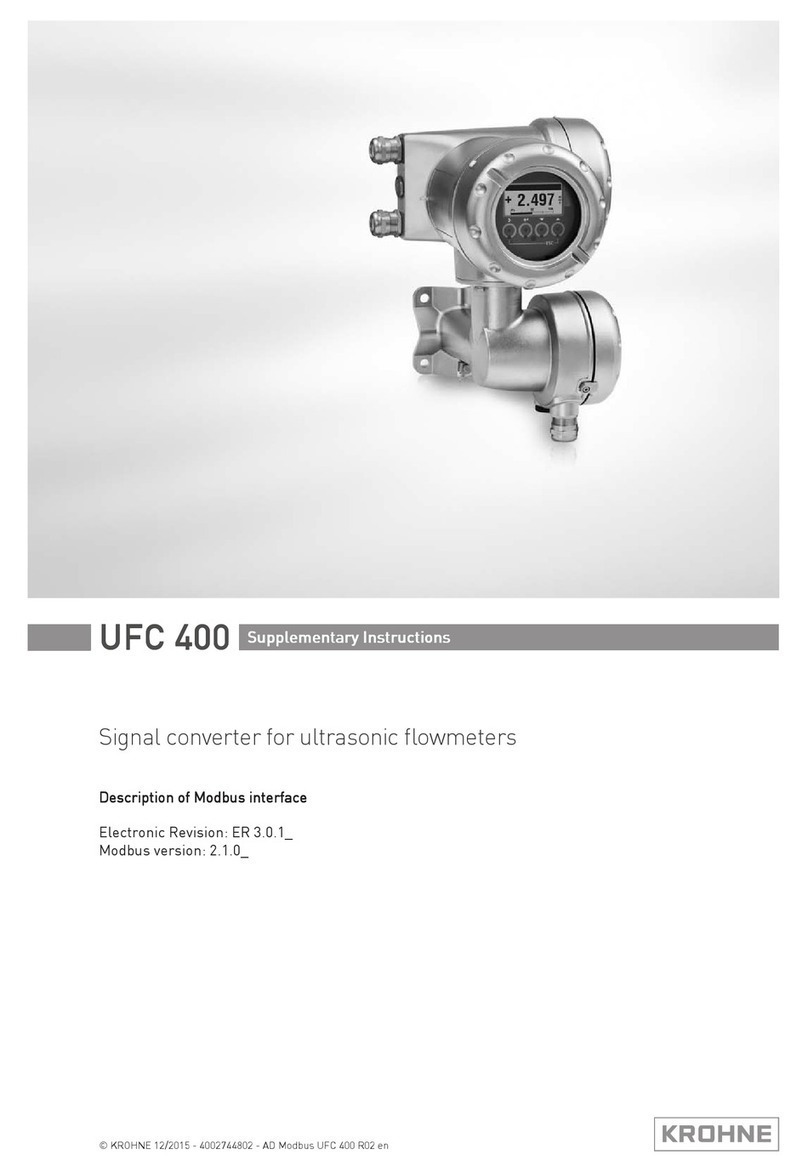
KROHNE
KROHNE UFC 400 Wiring diagram
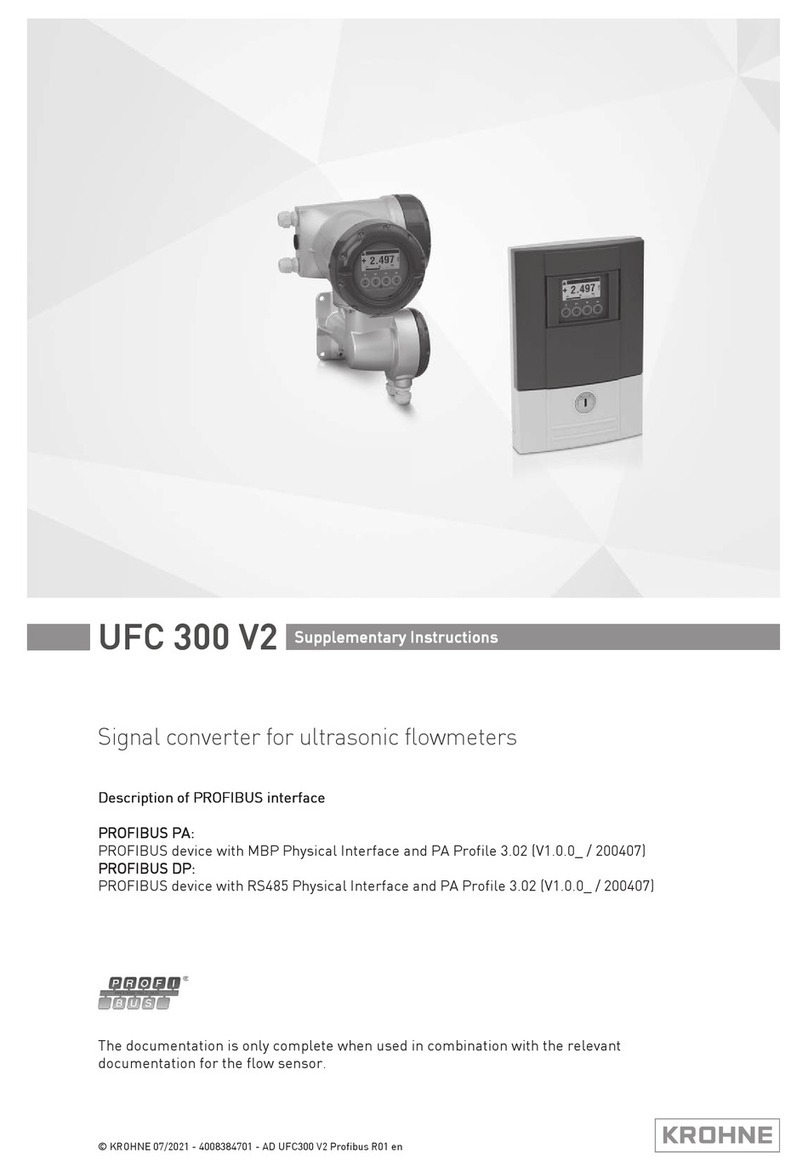
KROHNE
KROHNE UFC 300 V2 Wiring diagram
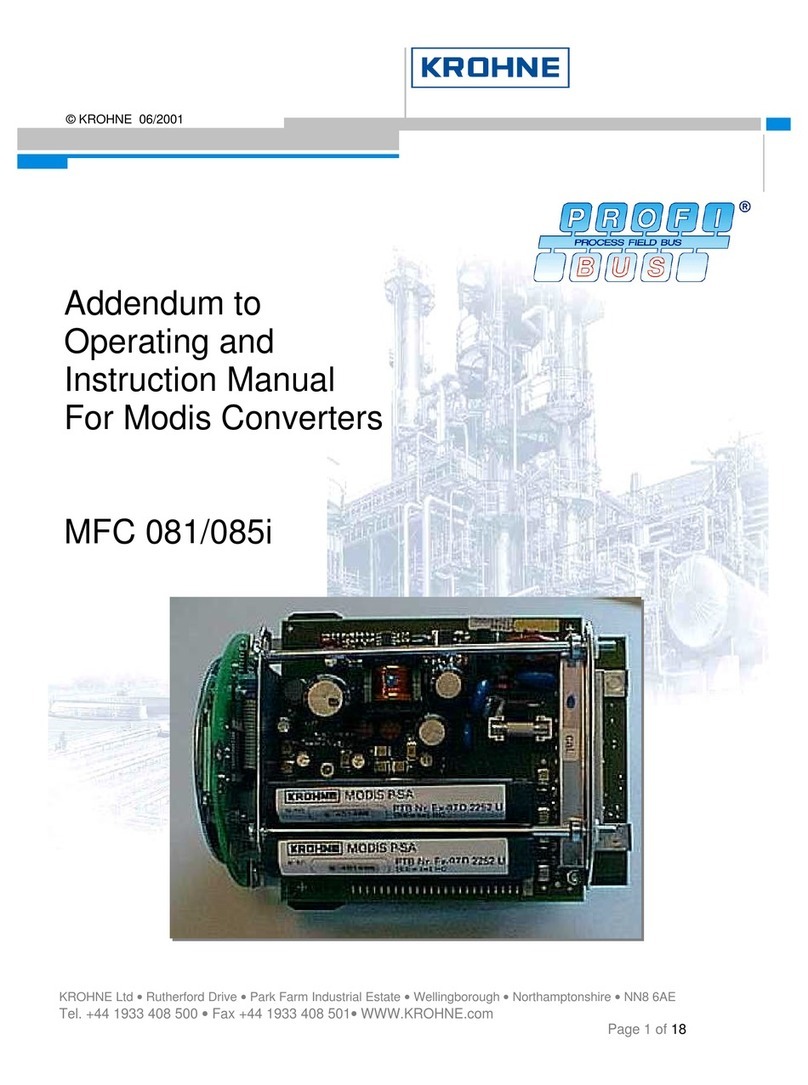
KROHNE
KROHNE MFC 081 Operating instructions
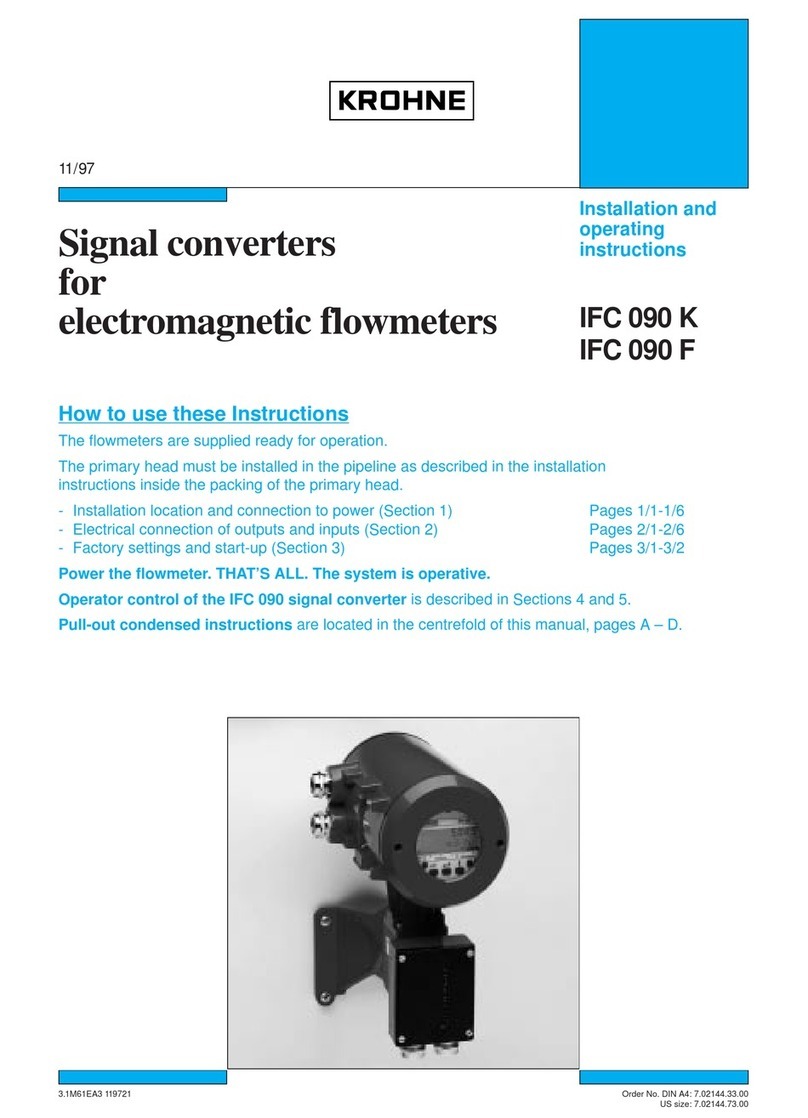
KROHNE
KROHNE IFC 090 K User manual
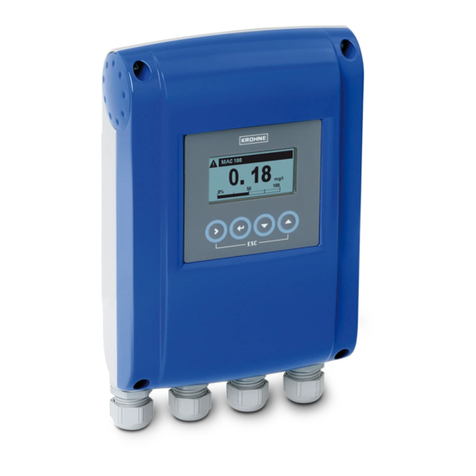
KROHNE
KROHNE MAC 100 User manual
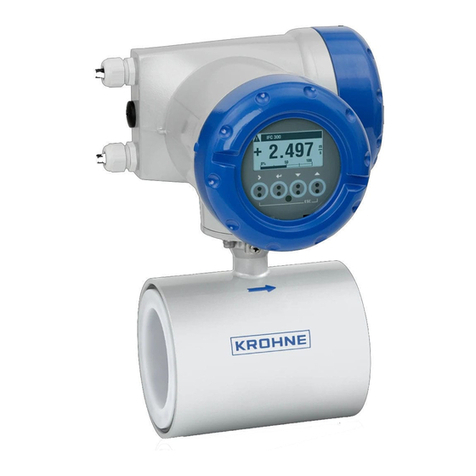
KROHNE
KROHNE ifc 300 User manual

KROHNE
KROHNE H250 M40 ESK4-Basic User manual
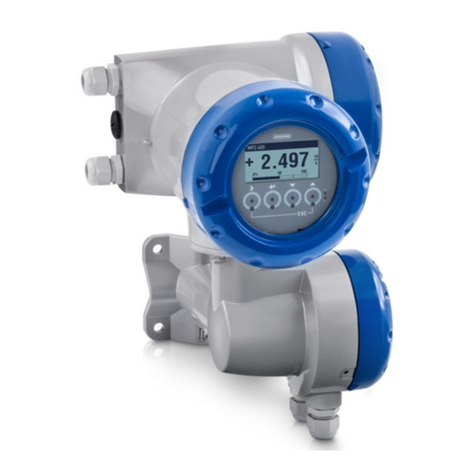
KROHNE
KROHNE MFC 400 Wiring diagram
Popular Media Converter manuals by other brands

CAMBOARD
CAMBOARD Extron Electonics YCV 100 user manual
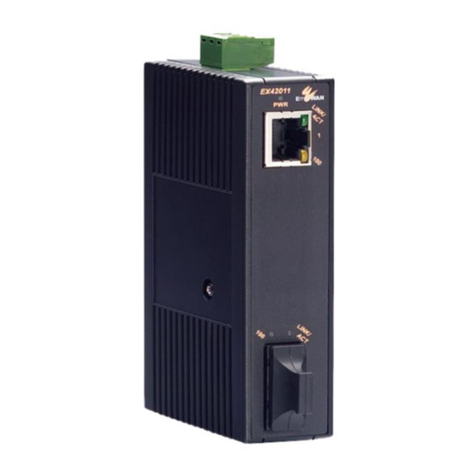
EtherWAN
EtherWAN EX42011 installation guide
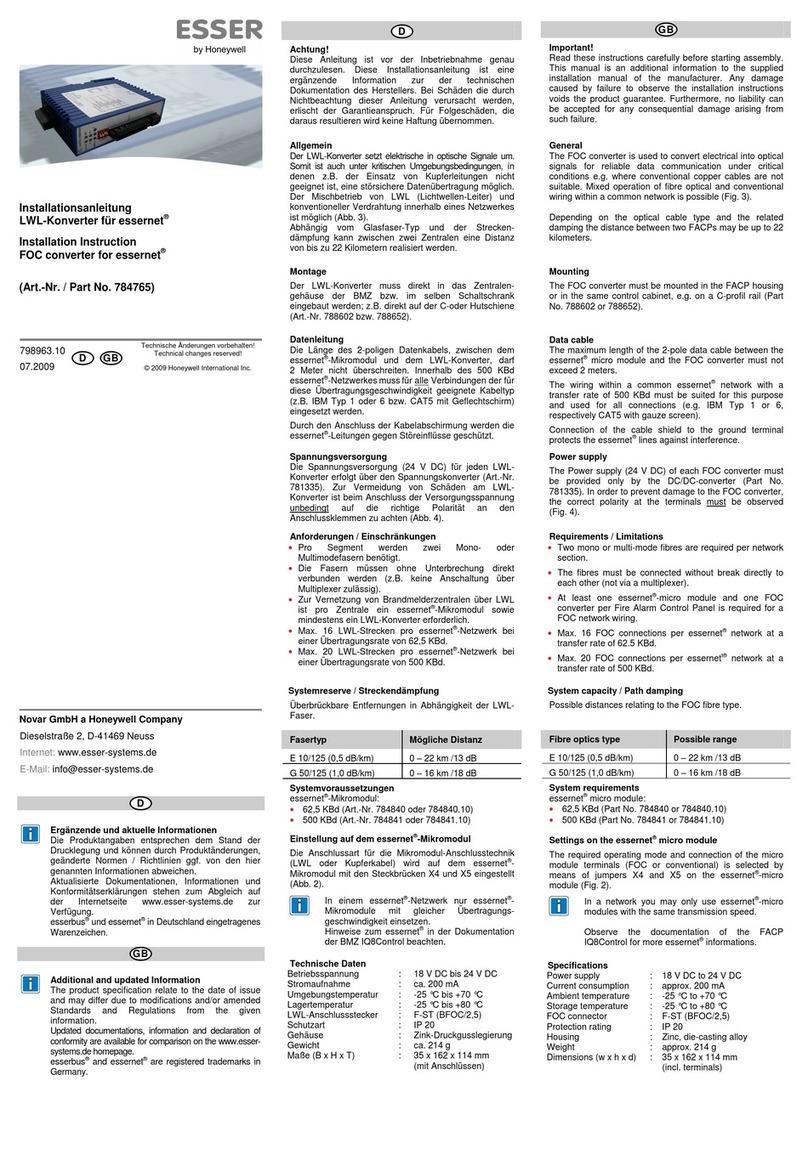
Esser
Esser 784765 Installation instruction
Schnick-Schnack-Systems
Schnick-Schnack-Systems DPB Pixel-Router Pro user guide
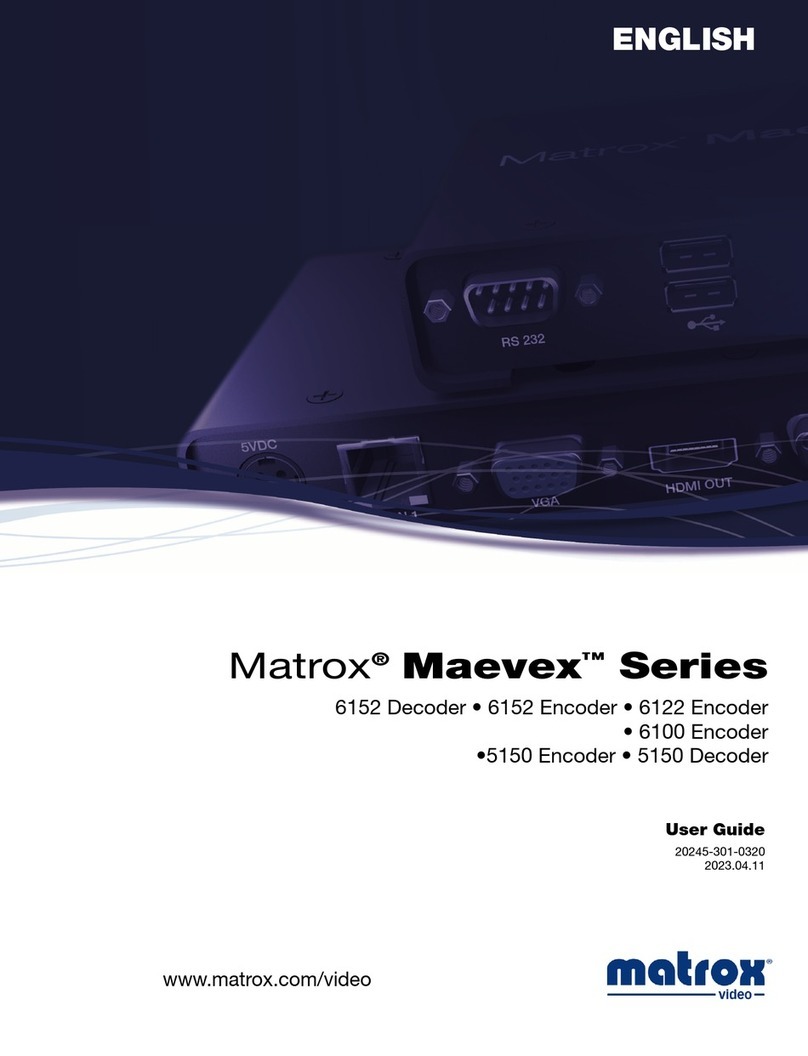
Matrox
Matrox Maevex 6152 Series user guide
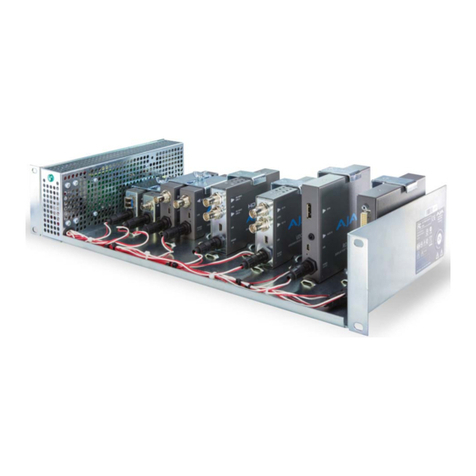
AJA
AJA DRM-R1 Installation & operation guide
